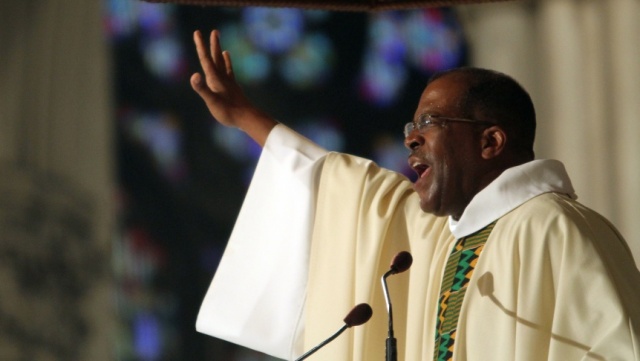Pope Benedict wrote in the Apostolic Exhortation
Verbum Domini that
“the homily is a means of bringing the scriptural message to life in a way that helps the faithful to realize that God’s word is present and at work in their everyday lives.” (VD 59) Add to that the 18 pages that Pope Francis dedicated to preaching in his Apostolic Exhortation,
Evangelii Gaudium. In it he writes:
“The homily is the touchstone for judging a pastor’s closeness and ability to communicate to his people. We know that the faithful attach great importance to it, and that both they and their ordained ministers suffer because of homilies: the laity from having to listen to them and the clergy from having to preach them!” (EG 135) It was with these thoughts in mind that I attended the preaching conference held at Toronto’s
St. Augustine’s Seminary last week. The conference was titled, “How to Make Catholic Preaching Better.”
I’m a deacon. I am the minister of the Word. I think homilies are important. But before I was a deacon, I thought homilies were important (I went to theatre school and have spent the last 30 years of my life doing live theatre, film and TV, so I’ve always been a bit critical of public speakers in general) and I suspect that most of you "attach great importance" to the homily, but did you know that according to the Church, preaching is the main duty of deacons, priests and bishops?
Fr. Guerric DeBona, OSB of St. Meinrad Seminary made this point very clear. In the Vatican II
decree on the ministry and life of priests it says,
“The People of God are joined together primarily by the word of the living God. And rightfully they expect this from their priests. Since no one can be saved who does not first believe, priests, as co-workers with their bishops, have the primary duty of proclaiming the Gospel of God to all. In this way they fulfill the command of the Lord: "Going therefore into the whole world preach the Gospel to every creature" (Mk 16:15) (Presbyterorum Ordinis #4) On the last day of the conference, Toronto Auxiliary Bishop, John Boissoneau reminded us that since the Council of Trent it has been the primary duty of Bishops to proclaim the Word of God.
So why is it that so often we come out of the Liturgy of the Word uninspired and unmoved? When was the last time you heard a good homily? Or better yet, what is a good homily? Toronto Deacon Peter Lovrick, who organized the conference began by telling us the results of a survey of conference participants: 50% said that generally in North America preaching needed improvement; however 43% of the respondents claimed that their preaching was “good”.
Fr. James Heft, SM of the Institute for Advanced Catholic Studies of the University of Southern California also shared the results of a survey he used to do with seminarians. Commonly they would say that 90% of homilists were poor preachers. At the same time, 90% of these same seminarians would often claim that they were good preachers.
When
Cardinal William Levada was Prefect of the Congregation for the Doctrine of the Faith I heard him say that a good homily had to be scriptural, catechetical, pastoral and liturgical. That means that first, it has to be based on the readings of the day. Not necessarily that they have to be a Bible study, but it should be rooted in the readings. But it also has to be an opportunity for teaching us something about our faith and our relationship with God. They need to be pastoral because everything we do as ministers of the Word (which is not just preaching, by the way) is pastoral. That’s why Pope Francis keeps reminding us that we need to smell like the sheep. The pastoral component of the homily is the part that connects with the listeners, helping them make sense in their lives what is being proclaimed. Lastly, the homily is not separate from the liturgy. There’s a reason why the homily happens in the Mass; it's not just a speech, lecture or sermon. The homily should invite us to respond to the Word through the Sacraments and through the Liturgy. It is always appropriate to lead out of the homily inviting people to enter into the next movement of the Liturgy. This should not be hard if the homily is indeed inviting us to praise and to thanksgiving. Outgoing rector of St. Augustine’s, Mons. Robert Nusca reminded us in his talk that a homily is not an academic exercise; it is rather a conversation between Christ and the people. The homily should lead to prayer, but also to thinking. Many of the other presenters said the same thing.
In Verbum Domini Pope Benedict also wrote:
“[The homily] should lead to an understanding of the mystery being celebrated, serve as a summons to mission, and prepare the assembly for the profession of faith, the universal prayer and the Eucharistic Liturgy.” (VD 59) I guess that's why I've been trying to say.
Several of the speakers at the conference made the point that while the preacher must be a listener of the Word, he must also be a listener of the people. A preacher must know the congregation. A preacher must be with the people; a shepherd must be with the sheep. Fr. Guerric DeBona who is also the author of the homiletics book that I studied with,
Preaching Effectively, Revitalizing Your Church (Paulist Press), said that the shaping of your homily text must be determined by who is listening: “If the text is not geared to the particular congregation, the word is not "
fulfilled in their hearing." He added that the text needs to be brought to life. The preacher needs to put flesh and bones to the message for that particular congregation. It sounds like something I would have learned in Theatre school.
The opening keynote address was given by Toronto's Archbishop, Cardinal Thomas Collins. One of his comments was that we must prepare the homilist before we prepare the homily. In fact, most of the speakers dedicated their talks to this very thing: helping prepare the homilist. The homilist has to be a man of prayer. The homilist has to in relationship with Scriptures. The homilist must be in constant study and prayer with the Word. As well as Cardinal Collins, four other of the eight presenters spoke about Lectio Divina and how important such type of prayer is for a homilist. Lastly, as I just wrote above, the homilist must be with the people.
The main question that I still have is what makes a good homily. I’m curious to know what you think. Do you believe that content is more important than style; that the medium is the message? Is it enough to have a great message if the preacher is not a good communicator? To read or not to read? To walk around or to stand behind the pulpit? If you are a preacher, how do you prepare? Write a comment; share with us what you think.
Attending the conference made me go back to a paper that I wrote for our homiletics class while I was in formation for the permanent diaconate. Come back on
Wednesday and I’ll share with you what I found.
To listen to a conversation I had with Fr. Guerric DeBona on this very subject, listen to the May 31, 2014 edition of the SLHour.
-
Photo credit: Jesuit Father Gregory C. Chisholm, pastor at St. Charles Borromeo Church in the Harlem section of New York, delivers a homily at St. Patrick's Cathedral in New York. (CNS photo/Gregory A. Shemitz)

Every week, Deacon Pedro takes a particular topic apart, not so much to explore or explain the subject to its fullness, but rather to provide insights that will deepen our understanding of the subject. And don’t worry, at the end of the day he always puts the pieces back together. There are no limits to deaconstructing: Write to him and ask any questions about the faith or Church teaching:
[email protected]
 Every week, Deacon Pedro takes a particular topic apart, not so much to explore or explain the subject to its fullness, but rather to provide insights that will deepen our understanding of the subject. And don’t worry, at the end of the day he always puts the pieces back together. There are no limits to deaconstructing: Write to him and ask any questions about the faith or Church teaching: [email protected]
Every week, Deacon Pedro takes a particular topic apart, not so much to explore or explain the subject to its fullness, but rather to provide insights that will deepen our understanding of the subject. And don’t worry, at the end of the day he always puts the pieces back together. There are no limits to deaconstructing: Write to him and ask any questions about the faith or Church teaching: [email protected]